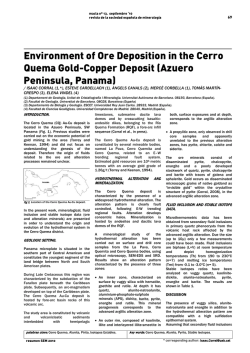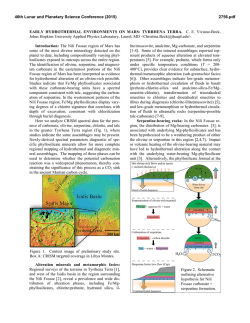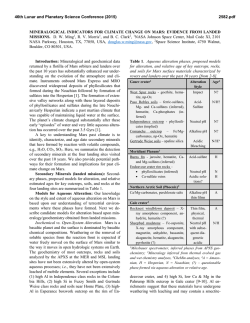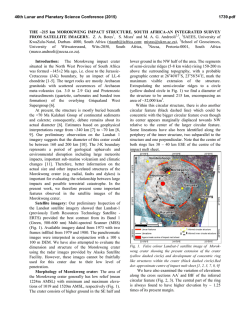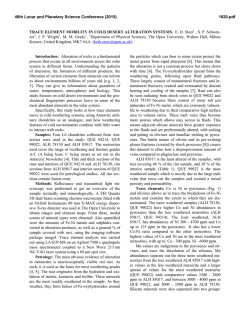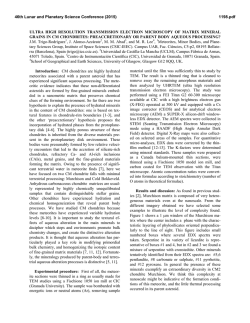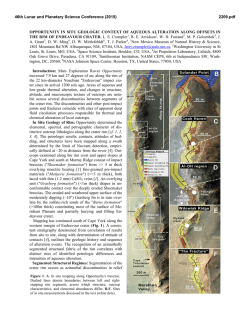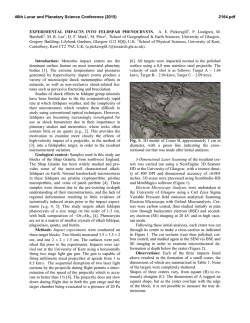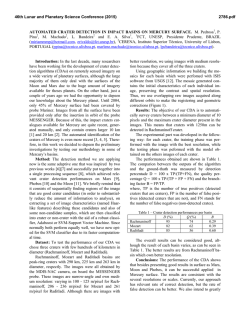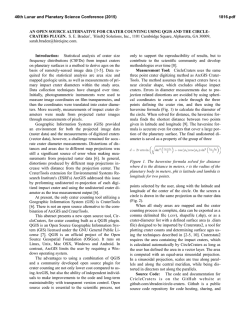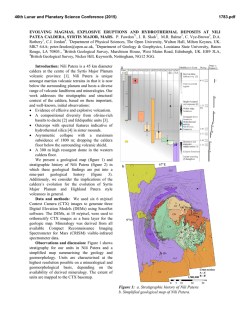
2917
46th Lunar and Planetary Science Conference (2015) 2917.pdf IMPACT-GENERATED HYDROTHERMAL ACTIVITY BEYOND THE RIES CRATER RIM. H. M. Sapers1,2, G. R. Osinski1,2,3, E. Buitenhuis2, N. R. Banerjee1,2, R. L. Flemming1,2, J., Hainge3, and S. Blain1. 1Centre for Planetary Science and Exploration, University of Western Ontario, London, ON, Canada, 1151 Richmond St, N6A 5B7 ([email protected]). 2Department of Earth Sciences. 3Department of Physics and Astronomy. Impact-generated hydrothermal activity: Hydrothermal activity is commonplace in the immediate aftermath of an impact event on any water-rich solid planetary surface [1]. Despite evidence for impactgenerated hydrothetmal activity being recognized at over 70 terrestrial impact structures [1,2] the temporal and spatial extent of these systems is still poorly understood. A two-stage cooling model is generally accepted: 1) rapid exponential convection driven cooling while temperatures are above the boiling point of water through steam production and degassing; 2) long period of gradual cooling once convection and steam production cease [3]. This latter phase may last for tens of thousands of years driven by heated materials and exothermal authigenic mineral reactions. During this second phase, ambient low temperature alteration such as divitrification of impact glass and aqueous weathering overlap with, and produce similar products such as secondary clays and zeolites, as hydrothermal processes and distinguishing the mechanisms can be difficult e.g.[3]. Controversory over the extent of the Ries impact-generated hydrothermal system: The Ries crater is one of the first impact sites where an impactgenerated hydrothermal system was proposed [3-6]. Despite intensive study, and long-standing recognition of secondary alteration phases, the extent of postimpact hydrothermal alteration within the surficial suevites beyond the inner crater ring is debated [7]. Three main alteration mineral phases have been identified: fine-grained clayey altered ground mass, platy Fe-montmorillonite, and Ba-phillipsite [3]. Detailed mineralogical and textural studies of the platy montmorillonite suggest a hydrothermal origin [3]. However, a series of isotopic studies conducted on the montmorillonite suggest precipitation from cool (16±5°C) fluids [8]. In contrast to the ejecta units beyond the crater rim, a hydrothermal system affecting the crater-fill units is widely accepted. Mineralogical evidence of hydrothermal alteration varies considerably between the crater fill units and ejecta. Intense pervasive hydrothermal alteration is limited to the crater suevites indicating that early, high temperature (200 – 300°C) hydrothermal activity was restricted to the crater fill units [3]. Alteration phases of the crater suevite include: Kfeldspar, albite, clays, chlorite, zeolites, calcite, and minor phases including pyrite, goethite, barite and si- derite consistent with an early, high-temperature (200300°C) phase of K-metasomatism coinciding with albitization and chloritization followed by pervasive intermediate argillic alteration and zeolitization. In contrast, alteration textures in the surficial suevite are dominantly spatially restricted and include coliform/rhythmic banding, vesicle infilling, and local pervasive alteration. Studies of the alteration textures of glassy and formerly glassy clasts within both the surfical and crater- fill suevites has shown a consist progression from fresh glass through incipient, low temperature alteration (perlitic fracturing, devitrification and decomposition textures) to evidence of fluid circulation (alteration zones surrounding perlitic fractures and vesicles, banding and zonation) resulting in progressive alteration (globular replacement textures, platy clays) and finally pervasive alteration and total replacement including the formation of Ba-phillipsite (harmatone) and montmorillonite in both the crater-fill and ejected glass-bearing breccias e.g. [3]. Clay phases within both the groundmass and replacing glassy clasts in the surficial suevite have long been recognized. The groundmass, defined as finegrained material enclosing fragments of shocked/ unshocked material c.f. [9], comprises 50–70 vol% of the surficial suevites and is ~50 vol% clayey material [9]. Early XRD analyses [10,11] of the clay phase were only able to definitively identify montmorillonite. Detailed EDS analyses [9] indicate that the composition of the clayey fraction of the groundmass has a highly variable composition not always consistent with montmorillonite. Large, areas of platy clays that crosscut the fine-grained clay matrix, however, always have compositions consistent with montmorillonite [9] and have been interpreted to have originated both from hydrothermal processes [3] and ambient weathering [7]. Montmorillonite comprises only <10 – 15 vol% of the clayey groundmass leaving the remaining ~50 vol% an unidentified X-ray amorphous clay or enigmatic hydrous phase [9]. Evidence against beyond-rim hydrothermal activity: Chemical and mineralogical arguments are based on comparisons of surface-exposed surficial suevite samples with crater suevite samples derived from depth from the Nördlingen drill core. The low temperature nature of the formation of the montmorillonite and lack of chemical variability between outcrops consistent with temperature zonation characteristic of hydrothermal systems is suggested to 46th Lunar and Planetary Science Conference (2015) restrict the alteration of the outer suevites to weathering, and not hydrothermal processes as initially suggested by [12] and [10] among others. Additional isotopic evidence against development of hydrothermal activity in the surficial suevites is presented by [8]. Using stable isotope data derived from 𝛿18O and 𝛿D fractionation in the smectitic clay, fluid temperatures were estimated at 16 ± 5°C, consistent with precipitation [8]. In comparison, 𝛿18O and 𝛿D values from smectite sourced from the crater fill material indicates fluid temperatures from 43 – 122 °C increasing with depth [8]. The authors conclude that the secondary clay phases in the crater-fill suevite (Fe-rich montmorillonite-type smectite and mixed layer illitesmectite) and the surficial suevite (dioctahedral Al-Fe montmorillonite) therefore formed from distinct mechanisms; hydrothermal generation and weathering respectively, supporting the hypothesis that the surficial suevites did not experience hydrothermal activity and were affected only by low-temperature weathering processes. Evidence supporting beyond-rim hydrothermal activity: Surface exposed samples of surficial suevite undoubtedly were subjected to ambient weather processes overprinting evidence of impact-generated hydrothermal processes. Further, if the surficial suevite was affected by the long-lived late stages of hydrothermal activity characterized by temperatures <100 °C [3] neither distinct temperature zonation nor high temperature K metasomatism as experienced by the craterfill unit would be expected in the surficial units. As such direct comparison between the crater-fill units sampled at depth and surface-exposed surficial suevite samples is of limited significance. Studies by [7,8,13] focus on montmorillonite within surface exposures of the surficial suevite. Platy montmorillonite comprises <10 – 15 vol% of the clayey groundmass and care should be taken to suggest it is representative of alteration phases. Furthermore, no attempt was made to ensure only the platy clays were used in analyses. Assuming some montmorillonite formation through weathering, and some through hightemperature divitrification, the derived temperatures represent a mixing of both phases and the reported temperature can only be taken as an average for all fluids leading to montmorillonite precipitation. The hypothesis that post-impact hydrothermal activity did not extend beyond the crater rim does not explain the Ba enriched phillipsite. It is significant to note that neither clasts of pre-impact target rocks nor impactite phases were enriched in Ba. Therefore the Ba must have been dissolved by the hydrothermal fluids, transported and precipitated during zeolitization of the surficial suevites [3]. 2917.pdf Mineralogical data from surfical suevite representing the vertical spatial extent of exposed outcrops show distinct variation [14]. The characteristic XRD peaks of illite and montmorillonite vary systematically suggesting mineralogical variation that correlates with outcrop scale evidence for locally intense, pervasive hydrothermal alteration such as zones of completely replaced glassy clasts and leaching zones. In previous studies, only surface exposed samples were studied leading to sampling bias, especially assuming weathering overprinting. Study of the Wörnitzostheim core, sampling surficial suevite at depth has shown alteration assemblages consistent with the surficial suevites defined by vesicle filling montmorillonite, Ba-rich phillipsite forming within vesicles, and groundmass montmorillonite [14]. At depth (>78 m) montmorillonite and illite become major components and zeolitization occurs. As the Wörnitzostheim core was buried beneath >20 m of sediment, surface weathering process cannot account for the observed alteration assemblages suggesting the presence of hydrothermal system beyond the crater rim at the Ries impact structure. Conclusions: Mineralogical data from surficial suevite samples at depth provide a better sample set to assess the extent of impact-generated hydrothermal activity as the effects from weathering processes are minimized. We suggest that alteration of the surficial suevite followed a progression from high- to lowtemperature with textures consistent with hydrothermal alteration, sensu stricto, between the two temperature end members. Hydrothermal alteration was likely preceded by high-temperature devitrification or autometamorphism and followed by low- temperature weathering. It is suggested that the impact-generated hydrothermal system at the Ries impact structure was much more extensive and pervasive outside the crater rim area than previously reported. [1] Naumov M. V. (2002) Impacts in Precambrian Shields 117–171. [2] Osinski G. R. et al. (2013) Icarus 224, 347–363. [3] Osinski G. R. (2005) Geofluids 5, 202– 220 (2005). [4] Engelhardt W. V. (1972) Contrib Mineral Petr 36, 265–292. [5] Salger M. V. (1977) Geolog Bavar 75, 67–73. [6] Stähle V. and Ottemann J. (1977) Geolog Bavar 73, 191–217. [7] Muttik N. et al. (2008) MAPS 43, 1827–1840. [8]. Muttik, N et al. (2010) EPSL 299, 190– 195. [9] Osinski, G. R. et al. (2004). MAPS 39, 1655– 1683. [10] Engelhardt W. V. and G. Graup G. (1984) Geol. Rundsch. 73 447–481. [11] Newsom, H. et al. (1986) J. Geophys Res 91, E239–E251. [12] Stähle, V. (1972) EPSL 17, 275–293. [13] Muttik, N. et al. (2011) EPSL 310, 244–251. [14] Sapers H. M. et al (2012) LPSC XLIII Abstract# 1915
© Copyright 2025
